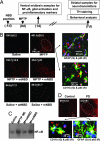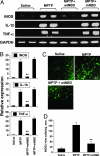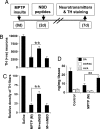Selective inhibition of NF-kappaB activation prevents dopaminergic neuronal loss in a mouse model of Parkinson's disease
- PMID: 18000063
- PMCID: PMC2141849
- DOI: 10.1073/pnas.0704908104
Selective inhibition of NF-kappaB activation prevents dopaminergic neuronal loss in a mouse model of Parkinson's disease
Abstract
Parkinson's disease (PD) is the second most common neurodegenerative disorder. Despite intense investigations, no effective therapy is available to stop its onset or halt its progression. The present study evaluates the ability of peptide corresponding to the NF-kappaB essential modifier-binding domain (NBD) of IkappaB kinase alpha (IKKalpha) or IKKbeta to prevent nigrostriatal degeneration in the 1-methyl-4-phenyl-1,2,3,6-tetrahydropyridine (MPTP) mouse model of PD and establish a role for NF-kappaB in human parkinsonism. First, we found that NF-kappaB was activated within the substantia nigra pars compacta of PD patients and MPTP-intoxicated mice. However, i.p. injection of wild-type NBD peptide reduced nigral activation of NF-kappaB, suppressed nigral microglial activation, protected both the nigrostriatal axis and neurotransmitters, and improved motor functions in MPTP-intoxicated mice. These findings were specific because mutated NBD peptide had no effect. We conclude that selective inhibition of NF-kappaB activation by NBD peptide may be of therapeutic benefit for PD patients.
Conflict of interest statement
The authors declare no conflict of interest.
Figures





References
-
- Hardy J, Cai H, Cookson MR, Gwinn-Hardy K, Singleton A. Ann Neurol. 2006;60:389–398. - PubMed
-
- Fahn S, Przedborski S. In: Merritt's Neurology. Rowland LP, editor. New York: Lippincott Williams & Wilkins; 2000. pp. 679–693.
-
- Dauer W, Przedborski S. Neuron. 2003;39:889–909. - PubMed
-
- Olanow CW, Tatton WG. Annu Rev Neurosci. 1999;22:123–144. - PubMed
-
- Gao HM, Liu B, Zhang W, Hong JS. Trends Pharmacol Sci. 2003;24:395–401. - PubMed
Publication types
MeSH terms
Substances
Grants and funding
LinkOut - more resources
Full Text Sources
Other Literature Sources
Medical
Molecular Biology Databases
Miscellaneous

